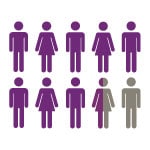Vaccine (Shot) for Human Papillomavirus

Pronounced [hu-man pap-il-lo-ma-vi-rus]
HPV vaccination is recommended at ages 11-12 years to protect against cancers caused by HPV infection.
When should my child get the shot?
11-12 Years
- Two doses of the HPV shot are needed, 6-12 months apart.
- If the shots are given less than 5 months apart, a 3rd dose is needed.
If started after 15th birthday
- Three doses of the HPV shot should be given over 6 months.
- If your teen hasn’t gotten the vaccine yet, talk to his/her doctor about getting it as soon as possible.
Your child can get the first dose of the HPV vaccine at the same visit they get vaccines to protect against meningitis and whooping cough.
Why does my child need the HPV shot?
- Protects against infections that can lead to certain cancers.
- Protects against abnormal cells that can lead to cancer (precancers) and the lasting effects of testing and treatment for these precancers.
- Protects your child long before they are ever exposed to cancer-causing infections.
The HPV shot is safe.
The HPV shot is very safe, and it is effective at protecting against HPV infection. Vaccines, like any medicine, can have side effects. These are usually mild and go away on their own.
With over 135 million doses distributed in the United States, HPV vaccine has a reassuring safety record that’s backed by over 15 years of monitoring and research.
What are the side effects?
The most common side effects of the HPV vaccine are mild and include:
- Pain, redness, or swelling in the arm where the shot was given
- Fever
- Dizziness or fainting (fainting after any vaccine, including HPV vaccine, is more common among adolescents)
- Nausea
- Headache or feeling tired
- Muscle or joint pain
To prevent fainting and injuries related to fainting, adolescents should be seated or lying down during vaccination and for 15 minutes after the shot.
It is important to tell the doctor or nurse if your child has any severe allergies, including an allergy to latex or yeast.
Prepare for your child’s vaccine visit and learn what you can do before, during, and after the vaccination.
Before, During, and After ShotsWhat is Human Papillomavirus (HPV)?
HPV is a group of more than 150 related viruses that infect men and women. These common viruses infect about 13 million people, including teens, every year. Some HPV infections can lead to certain types of cancer.
Is it serious?
While most HPV infections go away on their own, some infections that don’t go away can cause:
- Cervical, vaginal, and vulvar cancers in women
- Penile cancer in men
- Anal cancer in both men and women
- Cancer of the back of the throat, including the base of the tongue and tonsils (oropharynx) in both men and women
- Genital warts

85% of people will get an HPV infection in their lifetime.
While there is screening for cervical cancer, there are no routine screening tests for these other types of HPV cancers, so they often aren’t detected until they cause health problems.
Every year in the U.S.:
- More than 4,000 women die of cervical every year in the U.S., even with screening and treatment
- Nearly 36,000 men and women are diagnosed with a cancer caused by an HPV infection
- Nearly 200,000 women are estimated to be diagnosed with a cervical precancer, or abnormal cells on the cervix that can lead to cancer. Treatment for cervical cancers and precancers can limit women’s ability to have children
How do you get HPV?
HPV is spread through intimate skin-to-skin contact. You can get HPV by having vaginal, anal, or oral sex with someone who has the virus. It is most commonly spread during vaginal or anal sex. HPV is so common that nearly all men and women get it at some point in their lives.
Follow the vaccine schedule
The Centers for Disease Control and Prevention, American Academy of Family Physicians, and American Academy of Pediatrics strongly recommend children receive all vaccines according to the recommended vaccine schedule.
- Get a list of vaccines that your child needs based on age, health conditions, and other factors.
- Learn why you should follow the vaccine schedule.
